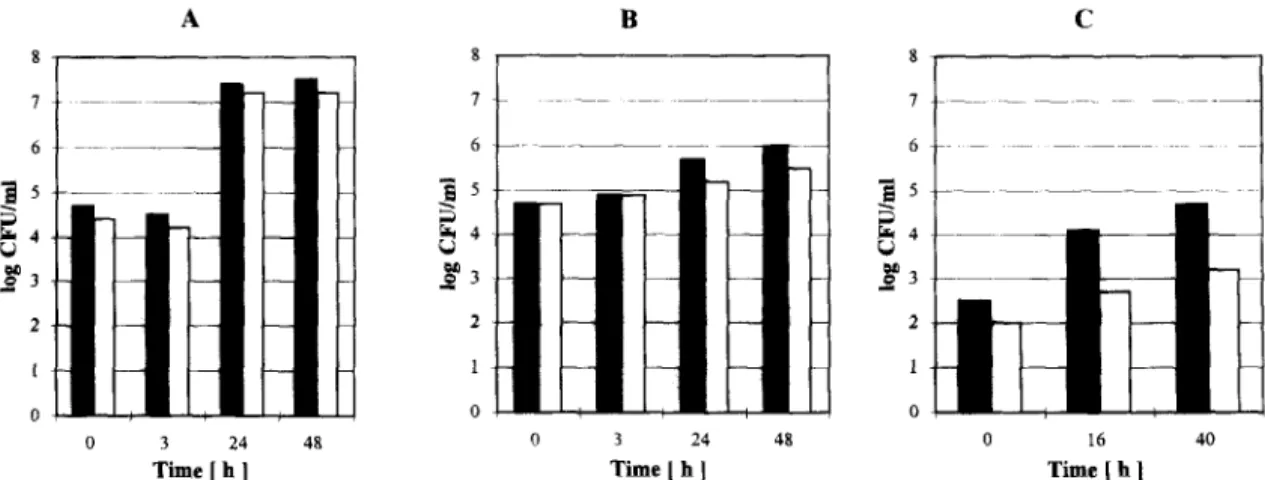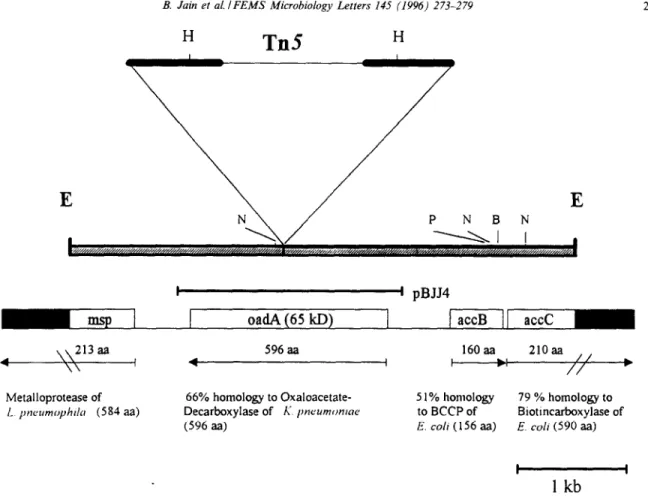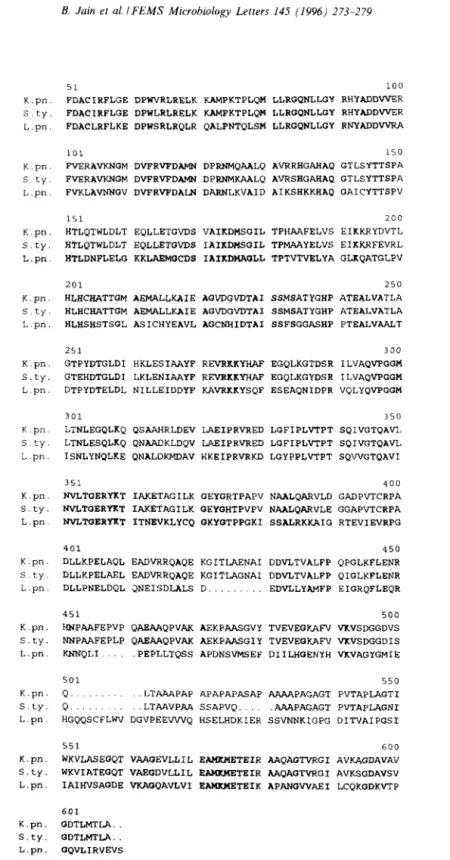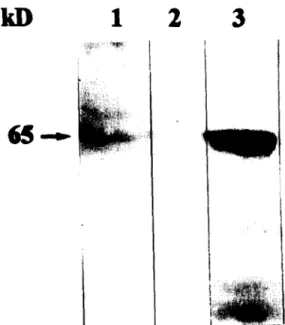EISEVIER
MICROBIOLOGY LETTERS FEMS Microbiology Letters 145 (1996) 273-279
An oxaloacetate decarboxylase homologue protein influences
the intracellular survival of
Legionella pneumophila
Bunty Jain ‘, Bettina C. Brand a, P. Christian Liick b, Marco Di Berardino ‘,
Peter Dimroth ‘, Jiirg Hacker a~*
a Institut fir Molekulare Infektionsbiologie, R6ntgenring 11, D-97070 Wiirzburg, Germany
b Institut fiir Medizinische Mikrobiologie and Hygiene, Universitiitsklinikum ‘Carl-Gustav-Car&, Diirerstr. 24, D-01307 Dresden, Germany ’ Mikrobiologisches Institut. Eidgentissische Technische Hochschule, Schmelzbergstr. 7, CH-8092 Ziirich, Switzerland
Received 22 August 1996; revised 30 September 1996; accepted 7 October 1996
Abstract
Legionella pneumophilu is a facultative intracellular parasite which is able to survive in various eukaryotic cells. We characterised a TnS-mutant of the L. pneumophila Corby strain and were able to identify the insertion site of the transposon. It is localised within an open reading frame which shows high homology to the a-subunit of the oxaloacetate decarboxylase (OadA) of Klebsiella pneumoniae. The OadA homologous protein of L. pneumophila was detected in the wild-type strain by Western blotting. Since the intracellular multiplication of the oadA_ mutant strain is reduced in guinea pig alveolar macrophages and human monocytes, it is concluded that the oadA gene product has an effect on the intracellular survival of L. pneumophila.
Keywords: Legionella pneumophila; Oxaloacetate decarboxylase; Intracellular survival
1. Introduction
Legionella pneumophila, the causative agent of Le- gionnaires’ disease, is a Gram-negative, rod-shaped, facultative intracellular bacterium [l]. In its natural aquatic habitat as well as in man-made water sys- tems, L. pneumophila is able to parasitise and repli- cate within free-living amoebae [2,3]. From this en- vironment L. pneumophilu can be transmitted by inhalation of bacteria containing aerosols to humans where it colonises the respiratory tract and multiplies intracellularly in the alveolar macrophages [4]. Only
* Corresponding author. Tel.: +49 (931) 312575; Fax: +49 (931) 571954; E-mail: j.hacker@rzbox.uni-wuerzburg.de
a few factors have been identified and characterised that contribute to the survival of the bacteria in eu- karyotic cells [5], such as the major outer membrane porin OmpS [6,7], the Mip protein Gacrophage infectivity Eotentiator) [8] and the two genetic loci designated icm (@tracellular Eultiplication) and dot @efect in organelle trafficking) [9,10]. To date, little is known about the physiology and metabolism of Legionella which differs from other bacterial species in using solely amino acids as main energy source and not glucose [l 11, and being very fastidious if cultivated under laboratory conditions. Nothing is known about the physiological parameters of Legio- nella strains, which may be essential to survive intra- cellularly in the different host cells.
037%1097/96/$12.00 Copyright 0 1996 Federation of European Microbiological Societies. Published by Elsevier Science B.V. PIISO378-1097(96)00424-7
3 24 48 0 3 24 48 0 16 40
Time[hl Time[h] Time [h]
Fig. I. Intracellular survival of L. pneumophilu strains in A. castellanii (A), human monocytes (B) and guinea pig alveolar macrophages (C). After an incubation time of 0, 3, 24 and 48 h, the formation of CFU of bacteria was determined in doublicates taken from three in- dependent experiments. The absence of error bars indicated that the standard deviation of the mean was smaller than the capacity of the graphic program. Shown are the wildtype L. pneumophila Corby (black bars) and the TnS-mutant L. pneumophila Corby E 25 (white
In this report, we describe the identification of a gene in L. pneumophila with homology to the a-sub- unit of the oxaloacetate decarboxylase of Klehsiellu pneumoniue. This gene, designated oadA, seems to modulate the ability of L. pneumophila to grow with- in alveolar macrophages of guinea pigs and human monocytes.
2. Material and methods 2.1. Bacterial struins
The strain L. pneumophilu Corby and the TnS-de- rivative L. pneumophilu Corby E 25 were described elsewhere [12,13]. The Legionella strains were cul- tured on buffered charcoal yeast extract (BCYE)- agar at 37°C with a 5% CO:! atmosphere for 2-3 days [14].
The Escherichiu coli strain DH5a [ 151 was used for DNA amplification and was grown on Luria-Bertani (LB)-agar or in LB-broth. For cloning purposes the vector pUC18 and the vector pBC KS+ were used. 2.2. Infection of eukaryotic host cells with
L. pneumophila
For invasion experiments human blood monocytes and alveolar macrophages of guinea pigs were used.
In addition, the protozoa Acanthamoeba castellunii was infected as an example for a natural host of L. pneumophila. The assays were carried out as de- scribed previously [13,16,17].
2.3. DNA manipulations and sequence analysis Isolation of plasmid DNA and recombinant DNA techniques were performed as described by Sam- brook et al. [18]. DNA amplification by polymerase chain reaction (PCR) was performed according to the method of Saiki et al. [19] using a Thermocycler 60 apparatus from Biomed (Theres, Germany). DNA sequence determination was carried out as de- scribed by the manufacturer with the T7 polymerase sequencing kit from Pharmacia (Freiburg, Germany) by using specific oligonucleotides as primers. Se- quence data were analysed and displayed using the University of Wisconsin Genetics Computer Group (GCG) Sequence Analysis Software Package [20]. Homology searches were conducted against the Gen- bank, EMBL, and Swiss-Prot data-bases using the FASTA program 1211.
2.4. SDS-PAGE and Western blot analysis Proteins were separated by SDS-polyacrylamide gel electrophoresis (10%) as described previously [22]. Western blotting was performed by semidry
B. Jain et al. IFEMS Microbiology Letters 145 (1996) 273-279 275
E
P NBN
I 1 pBJJ4
oadA (65 kD) accB accC
,,213 aa 596 aa 160aa 210aa 4 \\ I + I I // b Metalloprotease of I_ pwumophrltr (581 aa) 66% homology to Oxaloacetate- Decarboxylase of h’ ~~neurn~~nrn~ (596 aa) 5 1% homology 79 % homology to to BCCP of Biotmcarboxylase of E. co/r (156 aa) E. coli (590 aa)
I I
1 kb
Fig. 2. Map of the subcloned Tn5 insertion region of the mutant L. pneumophila E 25. Coding regions corresponding to mp, ondA, accB and accC are indicated by arrows. The sequenced region is shown as shaded bars and the unkwown sequence as black bars. BCCP is the biotin carboxyl carrier protein. Restriction endonuclease sites: B, BumHI; H, Hinⅈ E, EcoRI; N, NsiI; P, PvuI.
electroblotting in a graphite chamber according to the method of Kyhse-Anderson [23]. Polyclonal rab- bit antibodies against the OadA of K. pneumoniae were applied to the Western blot in a 1 : 500 dilution. For the detection of bound antibodies, peroxidase conjugated swine anti-rabbit IgG antibodies (DAKO, Hamburg, Germany) were used. The colour reaction was developed using 4,1-chloronaphtol.
3. Results and discussion
3.1. Intracellular survival of the L. pneumophila Corby TnS-mutant E 25 in several host cells In order to identify new virulence-associated genes, a mutagenesis using the transposon Tn5 was recently performed with the L. pneumophila strain
Corby [13], and the TnS-mutant E 25 was identified. The mutant E 25 showed no difference compared to the wild-type strain when tested for the expression of the genes pplA, mip, lly, htp and$aA in Western Blot analysis with specific antibodies (data not shown). To determine the capacity of mutant strain E 25 to multiply within host cells, we infected a variety of potential host cells with E 25 and its parental strain. The results are shown in Fig. 1. The wild-type strain L. pneumophila Corby and the mutant strain L. pneu- mophila E 25 were tested in cells such as human blood monocytes, cultured alveolar macrophages of guinea pigs and their natural aquatic host Acantha- moeba castellanii. In A. castellanii the TnS-mutant E 25 showed only a 2-fold unspecific difference in its ability to multiply intracellularly compared to the wild-type strain L. pneumophilu Corby (Fig. 1A). In contrast to this protozoa model a significant im-
276 B. Jain rt al. I FEMS Microbiology Letters 145 (1996) 273-279 K.Pil. s.ty. L.pn. K.pn. S ty. L.pn. K.pn. .%ty. L.pn. K.pn. S ty. L pn. K.pn. s.ty. L.pn. K Pn s ty. L prl K.pn. sty. L.pn. K.pn. s.ty. L.pn. K.pn. s.ty. L.pn. K.pn. s.ty. L.pIl K.pn. s.ty. L.prl. K.pn. s.ty. L.pn. 51 100
FDACIRFLGE DPWVRLRELK WPKTPLQM LLRQQNLLGY RHYADDWER FDACIRFLGE DPWLRLRELK KAMPKTPLQM LLRGQNLLGY RHYADDVVER FDACLRFLKE DPWSRLRQLR QALPNTQLSM LLRQQNLLGY RNYADDVVRA
101 150
FVERAVKNGM DVFRVFDM DPRNMQAALQ AVRRHGAHAQ GTLSYTTSPA FVERAVKNGM DVFRVFDAMN JJPRNMKAALQ AVRSHGAHAQ GTLSYTTSPA FVKLAVNNGV DVFRVFDALN DARNLKVAID AIKSHKKHAP OAICYTTSPV
151 200
HTLQTWLDLT EQLLETGVDS VAIKDMSGIL TPHAAFELVS EIRKRYDVTL HTLQTWLDLT EQLLETGVDS IAIXDMSGIL TPMAAYELVS EIKKRFEVRL WTLDNFLELG KKLAEMGCDS IAIKDMAGLL TPTVTVELYA GLKQATGLPV
201 250
HLHCHATTQM AEMALLKAIE ACVDGVDTAI SSMSATYGHP ATEALVATLA HLHCHATTGM AEMALLKAIE AGVDGVDTAI SSMSATYGHP ATEALVATLA HLHSHSTSGL ASICHYEAVL AGCNHIDTAI SSFSGGASHP PTEALVAALT
251 300
GTPYDTGLDI HKLESIAAYF REVRKKYHAF EGQLKGTDSR ILVAQWGGM GTEHDTGLDI LKLENIAAYF REZVRKKYHAF EGQLKGYDSR ILVAQVPGGM DTPYDTELDL NILLEIDDYF KAVRKKYSQF ESEAQNIDPR VQLYQWGGM
301 350
LTNLEGQLKQ QSAAHRLDEV LREIPRVRED LGFIPLVTPT SQIVGTQAVL LTNLESQLKQ QNAADKLDQV LAEIFRVRED LGFIPLVTPT SQIVGTQAVL ISNLYNQLKE QNALDKMDAV HKEIPRVRKD LGYPPLVTPT SQWGTQAVI
351 400
NVLTGERYKT IAKETAGILK QEYQRTPAPV NAALQARVLD GADPVTCRPA NVLTQERYICT IAKETAGILK GEYQHTPVPV NAALQARVLE GGAPVTCRFA NVLMERYKT ITNEVKLYCQ QKYQTPPGKI SSALRKKAIG RTEVIEVRFG
401 450
DLLKPELAQL EADVRRQAQE KGITLAENAI DDVLTVALFP QPGLKFLENR DLLKPELAEL EADVRRQAQE KGITLAGNAI DDVLTVALFP QIGLKFLENR DLLPNELDQL 2NEISDLALS D... EDVLLYAMFP EIGRQFLEQR
451 500
HNPAAFEPVP QAEAAQPVAK AEKPAASGVY TVEVEQKAFV MVSDGGDVS NNPAAFEPLP QAEAAQPVAK AEKPAASGIY TVEVEQKAFV VKVSDGGDIS KNNQLI.... .PEPLLTQSS APDNSVMSEF DIILHQENYH VKVAGYGMIE
501 550
Q. LTAAAPAP APAPAPASAP AARAPAGAGT PVTAPLRGTI Q... ..LTAAVPAA SSAPVQ.... .AAAPAGAGT PVTAPLAGNI HGQQSCFLWV DGVPEE~Q HsELHDKIER SSVNNKIGPG DITVAIPGSI
551 600
WKVUSEQQT VAAQEVLLIL EUUNETELR AAQAQTvRGI AVKAGDAVAV WKVIATEQQT VARQDVLLIL EAHlMETEIR AAQAQTVRGI AVKSGDAVSV IAIHVSAQDE VKAOQAVLVI EAMKMETEIK APANQWAEI LCQKQDKVTP
601 QDTLMTLA.. QDTLMTLA.. QQVLIRVEVS
Fig. 3. Amino acid sequence comparison of the L. pneumophih OadA and the oxaloacetate decarboxylases of K. pneumoniae and S. typhi- murium. Conserved amino acids are printed in bold letters.
B. Jain et al. IFEMS Microbiology Letters 14s (1996) 273-279 211
2
3
Fig. 4. Western blot analysis of total bacterial cell extracts using a polyclonal antibody against the OadA of K. pneumoniae. L. pneumophila Corby and L. pneumophila E 25 were grown on
BCYE-agar plates for 2-3 days. Equal amounts of extracts of
L. pneumophila Corby (lane l), L. pneumophila E 25 (lane 2) and
E. coli DHSa(pBJJ4) (lane 3) were applied to each lane.
paired intracellular growth within freshly isolated blood monocytes and cultured guinea pig alveolar macrophages could be detected (Fig. lB,C). In com- parison to the L. pneumophila Corby about 5-fold less bacteria were recovered from monocytes and about IO-fold less bacteria from alveolar macro- phages of guinea pigs infected with the L. pneumo- phila T&mutant E 25. These results implicate that the genetic defect of mutant strain E 25 may be of important significance for the survival of L. pneumo- phila in an environment offered by human blood monocytes and guinea pig alveolar macrophages, but not in A. castellanii. In spite of numerous simi- larities in the host-parasite relationship and the in- tracellular pathway of L. pneumophila in its different host cells like protozoa, human monocytes and al- veolar macrophages [24-261, we can conclude from our data that there occurs a host specificity in certain mutants of L. pneumophila. Obviously some factors seem to have an influence on the intracellular survi- val in monocytes and macrophages, which are not important in protozoa like A. castellanii.
3.2. IdentiJication of the TnS-insertion in the L. pneumophila chromosome
The chromosomal DNA of the mutant L. pneumo- phila E 25 was digested with the restriction enzyme
EcoRI to subclone the DNA fragment containing the transposon insertion into the vector pUC18. The de- sired fragment was identified by selection for the kanamycin resistance encoded by the Tn5. The re- sulting plasmid pBJE25 was subjected to sequence analysis. The DNA region upstream and down- stream of the Tn.5 insertion was sequenced on both strands with specific oligonucleotides as primers. Se- quence analysis revealed the presence of four open reading frames (ORF) as indicated in Fig. 2. We were able to identify the 5’-end of the L. pneumophila metalloprotease encoding gene msp and two addi- tional ORFs located on the opposite strand which displayed high homology to the biotin carboxyl car- rier protein (accB) and the biotin carboxylase (accC) of E. coli. While we could detect the entire ORF of accB, the 3’-end of accC was not present on pBJE25. The fourth ORF contains 1788 bp and is interrupted by the transposon insertion. The ORF is preceded by a potential ribosome-binding site at an appropriate distance from the putative initiation codon. This se- quence will appear in the EMBL/GenBank/DDBJ Nucleotide Sequence Data Libraries under the acces- sion number X99678.
3.3. IdentiJication of an OadA homologue protein The gene product deduced from the interrupted ORF consisted of 596 amino acids with a calculated molecular mass of 65 666 Dalton. Data-bank searches revealed a high degree of identity of the putative protein with the a-subunit of oxaloacetate decarboxylase of Klebsiella pneumonia [27] and Sal- monella typhimurium [28] with a similarity of 66% and 48% (Fig. 3). This enzyme consists of three dif- ferent subunits, a, p and y encoded by the genes oadGAB which are clustered on the genome of K. pneumoniae and S. typhimurium in that order. The oxaloacetate decarboxylase is an essential enzyme of the citrate fermentation pathway of these organisms. Under anaerobic conditions citrate is catabolised via oxaloacetate to acetate and formate. The biotin en- zyme oxaloacetate decarboxylase catalyses the decar-
278 B. Join el al. I FEMS Microbiology Letters 145 (1996) 273-279 boxylation of oxaloacetate to pyruvate and carbon
dioxide, and has the additional function as a primary sodium pump. Na’ bioenergetics are important as a link between exergonic and endergonic reactions in the membrane [29]. The oxaloacetate decarboxylase conserves the free energy of decarboxylation by con- version into an Na+ gradient.
As indicated in Fig. 4 Western blot analysis of the wild-type and mutant strain using a polyclonal anti- body against the OadA protein of Klebsiella pneumo- niae showed that the antibody reacted with an ap- proximately 65 kDa protein in the L. pneumophila Corby. This protein is not expressed in the Tn.S-mu- tant strain E 25. As a positive control we applied the strain DHSa(pBJJ4) to lane 3 (Fig. 4) where the OadA homologous protein is expressed. A 2.1 kb DNA fragment containing the wild-type oadA gene was amplified from the chromosome of L. pneumo- phila Corby by PCR, and subcloned in the vector pBC KS+, resulting in the recombinant plasmid pBJJ4 (Fig. 2). These data suggest that L. pneumo- phila expresses a protein homologous to the a-sub- unit of oxaloacetate decarboxylase of K. pneumoniae [27], and that the absence of this protein in the mu- tant L. pneumophila E 25 is due to the inactivation of the corresponding gene by the insertion of the Tn5 in this specific gene locus.
There is a possible explanation for the role of the oxaloacetate decarboxylase as a determinant of viru- lence in L. pneumophila. The intracellular microen- vironment in which Legionella strains reside is not well understood. Although Legionella requires a complex medium for growth in vitro, the intracellu- lar nutritional requirements are probably provided by the phagosome of human phagocytes and fresh- water protozoa. It is known, that besides amino acids also a-ketoglutarate and pyruvate can stimu- late growth of Legionella. Whether the protein homologous to the oxaloacetate decarboxylase a- subunit is part of an oxaloacetate decarboxylase complex or participates as a partial enzyme in an- other complex enzymatic reaction, e.g., the carbox- ylation of pyruvate, is unknown. In any case, the enzymatic reaction catalysed by this enzyme may be important to support growth of Legionella in its natural environment.
This is not the first reported case of a housekeep- ing protein being important for the virulence of an
organism. Recently, a pyruvate oxidase mutant of Streptococcus pneumoniae was found to be less viru- lent in the animal model, because the altered carbo- hydrate metabolism of these bacteria has an influ- ence on the adherence to host cells [30]. The virulence of L. pneumophila is a highly complex, mul- tifactorial phenomenon. Therefore it is likely that under certain intracellular conditions, enzymes like the oxaloacetate decarboxylase may play an essential role in the physiology of the bacteria and subse- quently exerting a global effect on the intracellular survival of L. pneumophila.
Acknowledgments
We thank M. Tully for providing the L. pneumo- phila strain E 25. This work was supported by a grant from the Bundesministerium fur Forschung und Technologie (BMFT 01 KI 9210) and by the Fonds der Chemischen Industrie.
References
[I] Winn, W.C. (1988) Legionnaires disease: a historical perspec- tive. Clin. Microbial. Rev. I, 60-81.
[2] Rowbotham, T.J. (1980) Preliminary report on the pathogeni- city of Legionellu neumophila for freshwater and soil amoebae.
J. Clin. Pathol. 33, 1179-1183.
[3] Barker, J. and Brown, M.R.W. (1994) Trojan horses of the microbial world: protozoa and the survival of bacterial patho- gens in the environment. Microbiology 140, 1253-1259. [4] Winn, W.C. and Myerowitz, R.L. (1981) The pathology of
Legionella pneumonias. Hum. Pathol. 12, 401422.
[5] Dowling, J.N., Saha, A.K. and Glew, R.H. (1992) Virulence factors of the family Legionellaceae. Microbial. Rev. 56, 32-
60.
[6] Bellinger-Kawahara, C. and Horwitz, M.A. (1990) Comple- ment component C3 fixes the major outer membrane protein (MOMP) of Legion& pneumophila and mediates hagocytosis
of 1iposomeeMOMP complexes by human monocytes. J. Exp. Med. 172, 1201&1210.
[7] Hoffman, P.S., Ripley, M. and Weeratna, R. (1992) Cloning and nucleotide sequence of a gene (ompS) encoding the major outer membrane protein of Legionella pneumophila. J. Bacter-
iol. 174, 914920.
[8] Cianciotto, N.P. and Fields, B.S. (1992) Legion& pneumo-
phi/a mip gene potentiates intracellular infection of protozoa
and human macrophages. Proc. Natl. Acad. Sci. USA 89, 5188-5191.
B. Jain et al. IFEMS Microbiology Letters 145 (1996) 273-279 219 Legionella pneumophila icm iocus: a set of genes required for [20] Devereux, J., Haeberli, P. and Smithies, 0. (1984) A compre- intracellular multiplication in human macrophages. Mol. Mi- hensive set of sequence analysis programs for the VAX. Nucl. crobiol. 35, 1048-1051. Acids Res. 12, 387-395.
[lo] Berger, K.H., Merriam, J.J. and Isberg, R.R. (1994) Altered intracellular targeting properties associated with mutations in
Legionella pneumophila dotA gene. Mol. Microbial. 14, 809- 822.
[21] Pearson, W.R. and Lipman, D.J. (1988) Improved tools for biological sequence comparison. Proc. Natl. Acad. Sci. USA 85, 24442448.
[I l] Tesh, M.T. and Miller, R.D. (1981) Amino acid requirements for Legionella pneumophila growth. J. Clin. Microbial. 13, 865-869.
[22] Laemmli, U.K. (1979) Cleavage of structural proteins during the assembly of the head of bacteriophage T4. Nature (Lond.) 227, 680-685.
[12] Jepras, RI., Fitzgeorge, R.B. and Baskervill, A. (1985) A comparison of virulence of two strains of Legionella pneumo- phila based on experimental aerosol infection of guinea pigs. J. Hyg. 95, 29-38.
[23] Kyhse-Andersen, J. (1984) Electroblotting of multiple gels: a simple apparatus without buffer tank for rapid transfer of proteins from polyacrylamide to nitrocellulose. J. Biochem. Biophys. Methods 10, 203-209.
[13] Tully, M., Williams, A. and Fitzgeorge, R.B. (1992) Transpo- son mutagenesis in Legionella pneumophila. II. Mutants exhi- biting impaired intracellular growth within cultured macro- phages and reduced virulence in vivo. Res. Microbial. 143, 481488.
[14] Edelstein, P.H. (1981) Improved semiselective medium for iso- lation of Legionella neumophila from contaminated clinical and environmental specimens. J. Clin. Microbial. 14, 298-303. [15] Bethesda Research Laboratories (1986) BRL pUC host E. coli
DH5a competent cells. Bethesda Res. Lab. Focus 8, 9. 1161 Wintermeyer, E., Ludwig, B., Steinert, M., Schmidt, B.,
Fischer, G. and Hacker, J. (1995) Influence of site specifically altered Mip proteins on intracellular survival of LegioneNa pneumophila in eukaryotic cells. Infect. Immun. 63, 45764583. [17] Steinert, M., Ott, M., Luck, P.C. and Hacker, J. (1994) Stud-
ies on the uptake and intracellular replication of Legionella pneumophilu in protozoa and in macrophage-like cells. FEMS
Microbial. Ecol. 15, 299-308.
[24] Abu Kwaik, Y. (1996) The phagosome containing Legionella pneumophila is surrounded by the rough endoplasmic reticu- lum. Appl. Environ. Microbial. 62, 2022-2028.
[25] Swanson, M.S. and Isberg, R.R. (1995) Association of Legio- nella pneumophila with the macrophage endoplasmic reticu- lum. Infect. Immun. 63, 3609-3620.
[26] Bozue, J.A. and Johnson, W. (1996) Interaction of Legionella pneumophila with Acanthamoeba castellanii: uptake by coiling phagocytosis and inhibition of phagosome-lysosome fusion. Infect. Immun. 64, 6688673.
[18] Sambrook, S., Fritsch, E.F. and Maniatis, T. (1989) Molecu- lar Cloning. A Laboratory Manual. Cold Spring Harbour, New York.
[19] Saiki, R.K., Gelfand, D.H., Stoffel, S., Scharf, S.J., Higuchi, R., Horn, G.T., Mullis K.B. and Erlich, H.A. (1988) Primer- directed enzymatic amplification of DNA with thermostable DNA-polymerase. Science 239, 487491.
[27] Schwarz, E., Oesterhelt, D., Reinke, H., Beyreuther, K. and Dimroth, P. (1988) The sodium ion translocating oxaloacetate decarboxylase of Klebsiella pneumoniae: sequence f the biotin- containing a-subunit and relationship to other biotin-contain- ing enzymes. J. Biol. Chem. 263, 9640-9645.
[28] Woehlke, G., Wifling, K. and Dimroth, P. (1992) Sequence of the sodium ion pump oxaloacetate decarboxylase from Salmo- nella typhimurium. J. Biol. Chem. 267, 22798-22803. [29] Dimroth, P. (1994) Bacterial sodium ion-coupled energetics.
Antonie-Van-Leeuwenhoek 5(4), 381-395.
[30] Spellerberg, B., Cundell, D.R., Sandros, J., Pearce, B.J., Idln- plan-Heikkill, I., Rosenow, C. and Masure, R. (1996) Pyru- vate oxidase, as a determinant of virulence in Streptococcus pneumoniae. Mol. Microbial. 19(4), 803-813.



